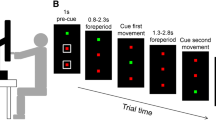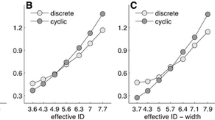Abstract
Fitts’ Law holds that, to maintain accuracy, movement times of aiming movements must change as a result of varying degrees of movement difficulty. Recent evidence has emerged that aiming to a target located last in an array of placeholders results in a shorter movement time than would be expected by the Fitts’ equation—a violation of Fitts’ Law. It has been suggested that the violation emerges because the performer adopts an optimized movement strategy in which they partially pre-plan an action to the closest placeholder (undershoot the last placeholder) and rely on a secondary acceleration to propel the limb toward the last location when it is selected as the target (Glazebrook et al. in Hum Mov Sci 39:163–176, 2015). In the current study, we examine this proposal and further elucidate the processes underlying the violation by examining limb displacement and corrective submovements that occur when performers aim to different target locations. For our Main Study, participants executed discrete aiming movements in a five-placeholder array. We also reanalyzed data from a previously reported study in which participants aimed in placeholder and no-placeholder conditions (Blinch et al. in Exp Brain Res 223:505–515, 2012). The results showed the violation of Fitts’ Law unfolded following peak velocity (online control). Further, the analysis showed that movements to the last target tended to overshoot and had a higher proportion of secondary submovements featuring a reversal than other categories of submovement (secondary accelerations, discontinuities). These findings indicate that the violation of Fitts’ Law may, in fact, result from a strategic bias toward planning farther initial displacements of the limb which accommodates a shorter time in online control.



Similar content being viewed by others
Notes
Only 11 of the 16 participants were featured in the reversal versus non-reversal MT analysis of the Main Study. This was because the five participants who were omitted failed to register a reversal/non-reversal submovement for at least one of the target locations.
There was a lower hit rate and greater tendency to overshoot in our Main Study compared to the reanalysis of Blinch et al. (2012). It is noteworthy that the hit rate in the Main Study was similar to previous studies exploring the violation of Fitts’ Law (e.g., 85–90 %, Adam et al. 2006; Pratt et al. 2007), while the seminal work of Fitts and Peterson (1964) indicated a hit rate of approximately 90 % (intermediate to both studies). The reason for the differences between the studies remains elusive, although we suspect it is due to subtle methodological differences. For example, there was an extended practice phase in the Blinch et al. (2012) study, where in the event a participant was inaccurate, they were encouraged to properly land on the target before they could start the experiment for real. There was no such practice phase for the Main Study. These differences are of limited theoretical significance as our main aim was to explore the differences between the conditions held within a single set of participants. In this respect, both studies demonstrated a similar pattern of results (i.e., limited differences between targets for hit rate and a greater terminal overshoot at the last-placed target).
Only 15 of the 20 participants were featured in the reversal versus non-reversal MT analysis of the reanalysis of Blinch et al. There were five participants who failed to register a reversal/non-reversal submovement for at least one of the target locations.
References
Adam JJ, van der Bruggen DPW, Bekkering H (1993) The control of discrete and reciprocal target aiming responses: evidence for the exploitation of mechanics. Hum Mov Sci 12:353–364. doi:10.1016/0167-9457(93)90025-K
Adam JJ, Mol R, Pratt J, Fischer MH (2006) Moving farther but faster: an exception to Fitts’s Law. Psychol Sci 17:794–798. doi:10.1111/j.1467-9280.2006.01784.x
Blinch J, Cameron BD, Hodges NJ, Chua R (2012) Do preparation or control processes result in the modulation of Fitts’ law for movement to targets with placeholders? Exp Brain Res 223:505–515. doi:10.1007/s00221-012-3277-3
Bradi AC, Adam JJ, Fischer MH, Pratt J (2009) Modulating Fitts’ Law: the effect of disappearing allocentric information. Exp Brain Res 194:571–576. doi:10.1007/s00221-009-1733-5
Burkitt JJ, Staite V, Yeung A, Elliott D, Lyons JL (2015) Effector mass and trajectory optimization in the online regulation of goal-directed movement. Exp Brain Res 233:1097–1107. doi:10.1007/s00221-014-4191-7
Chua R, Elliott D (1993) Visual regulation of manual aiming. Hum Mov Sci 12:365–401. doi:10.1016/0167-9457(93)90026-L
Desmurget M, Grafton S (2000) Forward modelling allows feedback control for fast reaching movements. Trends Cogn Sci 4:423–431. doi:10.1016/S1364-6613(00)01537-0
Elliott D, Helsen WF, Chua R (2001) A century later: woodworth’s two-component model of goal directed aiming. Psychol Bull 127:342–357. doi:10.1037/0033-2909.127.3.342
Elliott D, Hansen S, Mendoza J, Tremblay L (2004) Learning to optimize speed, accuracy, and energy expenditure: a framework for understanding speed-accuracy relations in goal-directed aiming. J Mot Behav 36:339–351. doi:10.3200/JMBR.36.3.339-351
Elliott D, Hansen S, Grierson LEM, Lyons JL, Bennett SJ, Hayes SJ (2010) Goal-directed aiming: two components but multiple processes. Psychol Bull 136:1023–1044. doi:10.1037/a0020958
Elliott D, Dutoy C, Andrew M, Burkitt JJ, Grierson LEM, Lyons JL, Hayes SJ, Bennett SJ (2014) The influence of visual feedback and prior knowledge about feedback on vertical aiming strategies. J Mot Behav 46:433–443. doi:10.1080/00222895.2014.933767
Fischer MH, Adam JJ (2001) Distractor effects on pointing: the role of spatial layout. Exp Brain Res 136:507–513. doi:10.1007/s002210000596
Fischer MH, Pratt J, Adam JJ (2007) On the timing of reference frames for action control. Exp Brain Res 183:127–132. doi:10.1007/s00221-007-1104-z
Fitts PM (1954) The information capacity of the human motor system in controlling the amplitude of movement. J Exp Psychol 47:381–391. doi:10.1037/h0055392
Fitts PM, Peterson JR (1964) Information capacity of discrete motor responses. J Exp Psychol 67:103–112. doi:10.1037/h0045689
Fradet L, Lee G, Dounskaia N (2008) Origins of submovements in movements of elderly adults. J Neuroeng Rehabil 5:28. doi:10.1186/1743-0003-5-28
Glazebrook CM, Kiernan D, Welsh TN, Tremblay L (2015) How one breaks Fitts’ Law and gets away with it: moving farther and faster involves more efficient online control. Hum Mov Sci 39:163–176. doi:10.1016/j.humov.2014.11.005
Glover S, Dixon P (2002) Dynamic effects of the Ebbinghaus illusion in grasping: support for a planning/control model of action. Percept Psychophys 64:266–278
Guiard Y (1993) On Fitts’s and Hooke’s law: simple harmonic movement in upper-limb cyclical aiming. Acta Psychol 82:139–159. doi:10.1016/0001-6918(93)90009-G
Hansen S, Glazebrook C, Anson JG, Weeks DJ, Elliott D (2006) The influence of advance information about target location and visual feedback on movement planning and execution. Can J Exp Psychol 60:200–208. doi:10.1037/cjep2006019
Howard LA, Tipper SP (1997) Hand deviations away from visual cues: indirect evidence for inhibition. Exp Brain Res 113:144–152
Keulen RF, Adam JJ, Fischer MH, Kuipers H, Jolles J (2002) Selective reaching: evidence for multiple frames of reference. J Exp Psychol Hum Percept Perform 28:515–526. doi:10.1037/0096-1523.28.3.515
Khan MA, Elliott D, Coull J, Chua R, Lyons JL (2002) Optimal control strategies under different feedback schedules: kinematic evidence. J Mot Behav 34:45–57. doi:10.1080/00222890209601930
Khan MA, Franks IM, Elliott D, Lawrence GP, Chua R, Bernier P, Hansen S, Weeks DJ (2006a) Inferring online and offline processing of visual feedback in target-directed movements from kinematic data. Neurosci Behav Rev 30:1106–1121. doi:10.1016/j.neubiorev.2006.05.002
Khan MA, Lawrence GP, Buckolz E, Franks IM (2006b) Programming strategies for rapid aiming movements under simple and choice reaction time conditions. Q J Exp Psychol 59:524–542. doi:10.1080/02724980443000809
Lyons JL, Hansen S, Hurding S, Elliott D (2006) Optimizing rapid aiming behaviour: movement kinematics depend on the cost of corrective modifications. Exp Brain Res 174:95–100. doi:10.1007/s00221-006-0426-6
Mendoza JE, Elliott D, Meegan DV, Lyons JL, Welsh TN (2006) The effect of the Müller-Lyer illusion on the planning and control of manual aiming movements. J Exp Psychol Hum Percept Perform 32:413–422. doi:10.1037/0096-1523.32.2.413
Meyer DE, Abrams RA, Kornblum S, Wright CE, Smith JEK (1988) Optimality in human motor performance: ideal control of rapid aimed movements. Psychol Rev 95:340–370. doi:10.1037/0033-295X.95.3.340
Neyedli H, Welsh TN (2012) The processes of facilitation and inhibition in a cue-target paradigm: insight from movement trajectory deviations. Acta Psychol 139:159–165. doi:10.1016/j.actpsy.2011.11.001
Oliveira FTP, Elliott D, Goodman D (2005) The energy minimization bias: compensating for intrinsic influence of energy minimization mechanisms. Mot Control 9:101–114
Pepper RL, Herman LM (1970) Decay and interference effects in the short-term retention of a discrete motor act. J Exp Psychol 83:1–18
Pratt J, Adam JJ, Fischer MH (2007) Visual layout modulates Fitts’s law: the importance of first and last positions. Psychon Bull Rev 14:350–355
Proteau L, Roujoula A, Messier J (2009) Evidence for continuous processing of visual information in a manual video-aiming task. J Mot Behav 41:219–231. doi:10.3200/JMBR.41.3.219-231
Radulescu PV, Al-Aidroos N, Adam JJ, Fischer MH, Pratt J (2011) Modulating Fitts’ Law: perceiving targets at the last placeholder. Acta Psychol 137:101–105. doi:10.1016/j.actpsy.2011.03.005
Roberts JW, Elliott D, Lyons JL, Hayes SJ, Bennett SJ (2016) Common vs. independent limb control in sequential vertical aiming: the cost of potential errors during extensions and reversals. Acta Psychol 163:27–37. doi:10.1016/j.actpsy.2015.10.004
Schmidt RA, Zelaznik HN, Hawkins B, Frank JS, Quinn JT (1979) Motor output variability: a theory for the accuracy of rapid motor acts. Psychol Rev 86:415–451. doi:10.1037/0033-295X.86.5.415
Sparrow WA, Newell KM (1998) Metabolic energy expenditure and the regulation of movement economy. Psychon B Rev 5:173–196. doi:10.3758/Bf03212943
Tipper SP, Lortie C, Bayliss GC (1992) Selective reaching: evidence for action-centered attention. J Exp Psychol Hum Percept Perform 18:891–905. doi:10.1037/0096-1523.18.4.891
Tresilian JR (1999) Selective attention in reaching: when is an object not a distractor? Trends Cogn Sci 3:407–408
Welsh TN, Elliott D (2004) Movement trajectories in the presence of a distracting stimulus: evidence for a response activation model of selective reaching. Q J Exp Psychol A 57:1031–1057. doi:10.1080/02724980343000666
Welsh TN, Elliott D (2005) The effects of response priming on the planning and execution of goal-directed movements in the presence of a distracting stimulus. Acta Psychol 119:123–142. doi:10.1016/j.actpsy.2005.01.001
Welsh TN, Elliott D, Weeks DJ (1999) Hand deviations toward distractors. Evidence for response competition. Exp Brain Res 127:207–212. doi:10.1007/s002210050790
Wolpert DM, Ghahramani Z (2000) Computational principles of movement neuroscience. Nat Neurosci 3:1212–1217. doi:10.1038/81497
Wolpert DM, Miall RC, Kawato M (1998) Internal models in the cerebellum. Trends CognSci 2:338–347. doi:10.1016/S1364-6613(98)01221-2
Woodworth RS (1899) The accuracy of voluntary movement. Psychol Rev 3(Monograph Suppl):1–119
Worringham CJ (1991) Variability effects on the internal structure of rapid aiming movements. J Mot Behav 23:75–85. doi:10.1080/00222895.1991.9941595
Acknowledgments
These works were supported by several grants awarded from the Natural Sciences and Engineering Research Council (NSERC) of Canada. We thank Dr. Steve Hansen for his ideas on how best to present the data.
Author information
Authors and Affiliations
Corresponding author
Rights and permissions
About this article
Cite this article
Roberts, J.W., Blinch, J., Elliott, D. et al. The violation of Fitts’ Law: an examination of displacement biases and corrective submovements. Exp Brain Res 234, 2151–2163 (2016). https://doi.org/10.1007/s00221-016-4618-4
Received:
Accepted:
Published:
Issue Date:
DOI: https://doi.org/10.1007/s00221-016-4618-4




